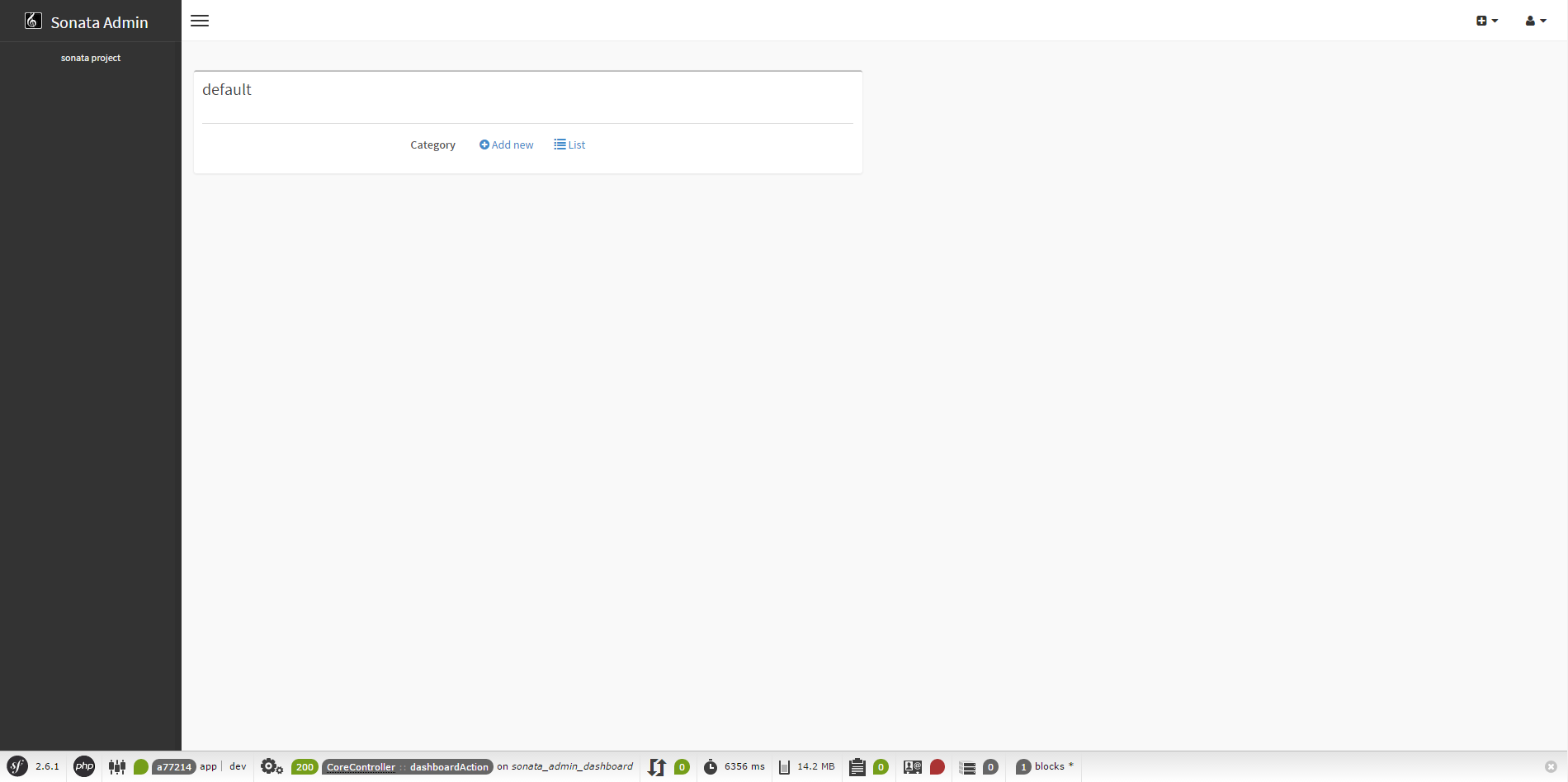2. Creating an Admin¶
You’ve been able to get the admin interface working in the previous chapter. In this tutorial, you’ll learn how to tell SonataAdmin how an admin can manage your models.
2.1. Step 0: Create a Model¶
For the rest of the tutorial, you’ll need some sort of model. In this tutorial,
BlogPost and Category will be used:
// src/Entity/BlogPost.php
// ...
class BlogPost
{
// ...
/**
* @var string
*
* @ORM\Column(name="title", type="string")
*/
private $title;
/**
* @var string
*
* @ORM\Column(name="body", type="text")
*/
private $body;
/**
* @var bool
*
* @ORM\Column(name="draft", type="boolean")
*/
private $draft = false;
/**
* @ORM\ManyToOne(targetEntity="Category", inversedBy="blogPosts")
*/
private $category;
}
1 2 3 4 5 6 7 8 9 10 11 12 13 14 15 16 17 18 19 20 21 22 23 24 25 26 27 28 29 30 | // src/Entity/Category.php
use Doctrine\Common\Collections\ArrayCollection;
class Category
{
// ...
/**
* @var string
*
* @ORM\Column(name="name", type="string")
*/
private $name;
/**
* @ORM\OneToMany(targetEntity="BlogPost", mappedBy="category")
*/
private $blogPosts;
public function __construct()
{
$this->blogPosts = new ArrayCollection();
}
public function getBlogPosts()
{
return $this->blogPosts;
}
}
|
After this, create the schema for these entities:
1 | bin/console doctrine:schema:create
|
Note
This article assumes you have basic knowledge of the Doctrine2 ORM and you’ve set up a database correctly.
2.2. Step 1: Create an Admin Class¶
SonataAdminBundle helps you manage your data using a graphical interface that will let you create, update or search your model instances. The bundle relies on Admin classes to know which models will be managed and how these actions will look like.
An Admin class decides which fields to show on a listing, which fields are used to find entries and how the create form will look like. Each model will have its own Admin class.
Knowing this, let’s create an Admin class for the Category entity. The
easiest way to do this is by extending Sonata\AdminBundle\Admin\AbstractAdmin:
// src/Admin/CategoryAdmin.php
namespace App\Admin;
use Sonata\AdminBundle\Admin\AbstractAdmin;
use Sonata\AdminBundle\Datagrid\ListMapper;
use Sonata\AdminBundle\Datagrid\DatagridMapper;
use Sonata\AdminBundle\Form\FormMapper;
use Symfony\Component\Form\Extension\Core\Type\TextType;
final class CategoryAdmin extends AbstractAdmin
{
protected function configureFormFields(FormMapper $formMapper)
{
$formMapper->add('name', TextType::class);
}
protected function configureDatagridFilters(DatagridMapper $datagridMapper)
{
$datagridMapper->add('name');
}
protected function configureListFields(ListMapper $listMapper)
{
$listMapper->addIdentifier('name');
}
}
So, what does this code do?
- configureFormFields(): This method configures which fields are displayed on the edit
and create actions. The
FormMapperbehaves similar to theFormBuilderof the Symfony Form component; - configureDatagridFilters(): This method configures the filters, used to filter and sort the list of models;
- configureListFields(): Here you specify which fields are shown when all models are
listed (the
addIdentifier()method means that this field will link to the show/edit page of this particular model).
This is the most basic example of the Admin class. You can configure a lot more with the Admin class. This will be covered by other, more advanced, articles.
2.3. Step 3: Register the Admin class¶
You’ve now created an Admin class, but there is currently no way for the
SonataAdminBundle to know that this Admin class exists. To tell the
SonataAdminBundle of the existence of this Admin class, you have to create a
service and tag it with the sonata.admin tag:
- YAML
1 2 3 4 5 6 7 8 9
# config/services.yaml services: # ... admin.category: class: App\Admin\CategoryAdmin arguments: [~, App\Entity\Category, ~] tags: - { name: sonata.admin, manager_type: orm, label: Category }
The constructor of the base Admin class has many arguments. SonataAdminBundle provides a compiler pass which takes care of configuring it correctly for you. You can often tweak things using tag attributes. The code shown here is the shortest code needed to get it working.
2.4. Step 4: Register SonataAdmin custom Routes¶
SonataAdminBundle generates routes for the Admin classes on the fly. To load these routes, you have to make sure the routing loader of the SonataAdminBundle is executed:
- YAML
1 2 3 4 5 6 7
# config/routes/sonata_admin.yaml # ... _sonata_admin: resource: . type: sonata_admin prefix: /admin
2.5. View the Category Admin Interface¶
Now you’ve created the admin class for your category, you probably want to know how this looks like in the admin interface. Well, let’s find out by going to http://localhost:8000/admin

Feel free to play around and add some categories, like “Symfony” and “Sonata
Project”. In the next chapters, you’ll create an admin for the BlogPost
entity and learn more about this class.
Note
If you’re not seeing the nice labels, but instead something like “link_add”, you should make sure that you’ve enabled the translator.